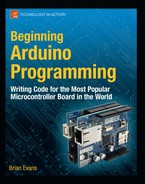C H A P T E R 12
Beginning Electronics
Normally, in a book that is primarily focused on how to program the Arduino microcontroller, it makes sense not to spend too much time on basic electronics theory. That's not to say that knowledge of electronics isn't helpful to Arduino programmers, but an honors degree in electronics theory is not an absolute prerequisite to programming microcontrollers either. That is why this chapter finds its home here at the end of our book, as a brief introduction to beginning electronics; or if you already know how to solder and read schematics, it couldn't hurt to have a refresher. Hopefully, this chapter will help to explain in more depth some of the concepts we have discussed elsewhere in the book and maybe even inspire new and interesting projects.
With that in mind, this chapter will begin with a review of the theory of beginning electronics through the use of a range of electronic hardware. We will look at the basics of a circuit, including many of the common components, how to identify them, and how we can use them in our projects. We will also cover how to read schematics to build prototypes of circuits on breadboards. With all this out of the way, we will wrap up the chapter with a little primer on the basics of soldering to help, at the very least, with attaching pins to some of the breakout boards that we have used throughout the book.
What's needed for this chapter:
- Arduino Uno
- Assorted breakout boards or things to solder
- 0.1” male pin headers
- 5mm LED of any color
- 220-ohm ¼-watt resistor or similar
- Momentary pushbutton or switch
- 9-volt battery
- Hookup wires
- Solderless breadboard
- Soldering iron
- Rosin core solder
- Sponge
